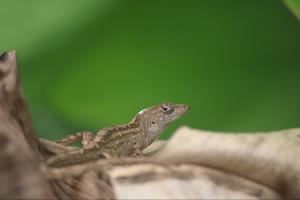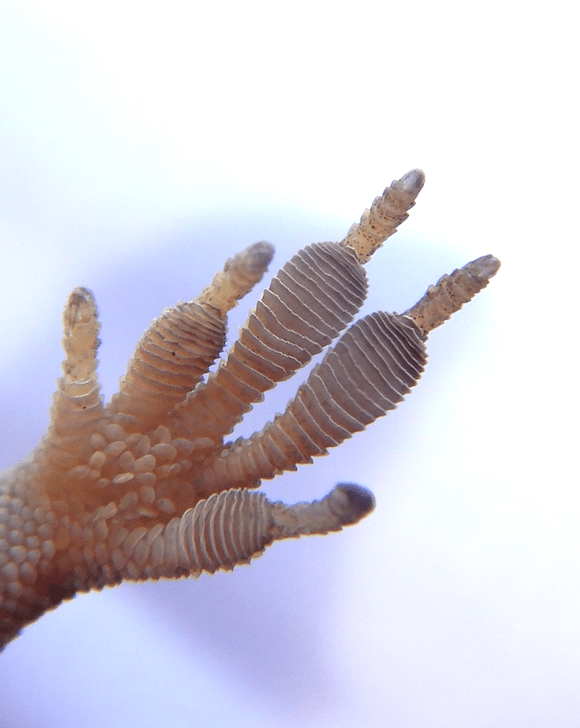lizards use habitat in ways that match their clinging ability
In this month’s cover image story we see that lizards vary in their ability to cling to different kinds of surfaces, and how this can lead to species sharing habitat.

How can lizards stick to smooth surfaces?
Have you ever seen a lizard run up a window and wondered how they do it? Geckos and anoles can cling to a variety of surfaces with their unique adhesive toe pads, each of which are covered in hundreds of thousands of microscopic hair-like structures called setae. The tips of the setae are so tiny that molecular bonds called Van der Waals forces form between them and a surface. Moreover, movement of the setae against a surface also creates friction. The smoother a surface is, the more points of contact there are between the setae and surface, which produces more total frictional adhesive force. On the flip side, rough surfaces, like rocks, have peaks and valleys, so not all of the setae can contact the surface, making it harder to cling using toe pads alone. The day geckos in our study (Phesluma laticauda) only have toe pads, but the anoles also have claws that can help them grip onto rougher surfaces.
So which is better for clinging, pads or pads + claws?
By and large, previous work tends to show that geckos are superior clingers compared to anoles, but a lot of that research has tested clinging performance on artificially smooth substrates like acrylic, where claws don’t come into play. In our paper, we wanted to answer, how does performance vary on the kinds of real-world substrates that lizards use in nature? And does this performance translate into lizards choosing to use microhabitats that suit their abilities the best?
How do you tell who is the best at clinging?

We started by testing each of the lizards’ clinging ability in controlled conditions. To test clinging ability, we place a lizard’s foot on a surface then pull them gently so that their foot is moving parallel to the surface. Using a force gauge, we measure how much force it takes to pull the lizard off: more force = greater clinging ability. We tested our lizards on 10 different substrates, most of which they use in nature. This turned out to be really important, because we found that which lizard is the best depends on which substrates you test them on. Green anoles were just as good as day geckos on artificially smooth acrylic, but day geckos were better than anoles on naturally smooth surfaces. On rough surfaces no one was the best: all three species were similar. This is key for linking morphology (i.e., how an organism is built) and performance to ecology: if you want to know how a lizard will use habitat, you need to test them on the types of surfaces they will actually encounter. Artificially smooth substrates allow you to measure maximum performance, but that is not necessarily what drives real-world habitat use. So a key insight from our work is that how researchers measure performance needs to be informed by what questions they are trying to answer: who is best under ideal conditions vs. who is best in this specific ecological context?
Introduced species provide a research opportunity.

Not only did we show that clinging ability varies across natural substrates, but we took advantage of the fact that anoles and day geckos have previously been introduced to Hawai’i to see how differences in clinging ability translate into differences in ecology. We did this by placing lizards in experimental enclosures and then observing which surfaces lizards used the most. Enclosures allow us to control habitat availability so that all lizards have the same substrates from which to choose. This would be very hard to do without the introductions because these lizards do not co-occur naturally–day geckos are from Madagascar and the Indian Ocean, and anoles are from the Americas and the Caribbean. While a lot of research on introduced species focuses on their impacts on native ecosystems, here we ask, “what can we learn from the chance events that brought some of nature’s best climbers together in Hawai’i?”
Lizards choose to use perches that match their abilities on natural substrates.

We collected over 11,000 observations where we saw a lizard and recorded the characteristics of the substrate on which it was perching (this is a lot of observations!), and found that clinging performance on natural substrates predicted habitat use in the field, but performance on artificial substrates did not. Even though they cling best to smooth acrylic, brown anoles do not cling well to naturally smooth substrates like leaves, and were almost always observed on rough substrates in the field. Day geckos can cling to naturally rough substrates like bark just as well as brown anoles can, but they cling much better to naturally smooth substrates, and that’s where we saw them perching most of the time. Green anoles had similar clinging ability on both rough and smooth natural substrates, and used both with equal frequency. These results further underscore the importance of testing performance in ecologically-relevant ways.
The bigger picture

Our overarching motivation for studying these lizards is to understand how the species are likely to interact and whether all three are able to coexist long term. Illuminating the link between clinging performance and habitat use helps us do this by providing a mechanism by which the species could be partitioning habitat. Differences in clinging abilities and habitat preferences allows the three species to use different parts of the environment, which may help them coexist: brown anoles prefer low, rough perches, day geckos prefer high, smooth perches, and green anoles prefer high perches of either texture. So as long as a diversity of perch types are available, the three species can spread out in the habitat. Thus by linking traits like clinging ability to habitat use, we can understand how different species can live together and how they might respond to environmental changes, even if they have never encountered each other before like in this novel community in Hawai’i.
About the researchers

I (Amber Wright) was born and raised in Honolulu, Hawai’i, and grew up catching green anoles–locally pronounced as a-KNOW-lees–which at the time were widespread and abundant. As a little girl I would catch them during recess and keep them in my pencil case during class. Even though green anoles are not native, lizards (mo’o in the Hawaiian language) have a lot of cultural significance here, and I remember being very worried as a kid about what would happen after brown anoles and day geckos arrived in the islands. By the time I applied to graduate school, green anoles were already much less common, and I proposed to study how these three species interact. I ended up studying a bunch of other things instead, but twenty years later I was finally able to pursue these questions when I became a professor back home at the University of Hawai’i at Mānoa. This paper is the first of many on this fascinating system that I have loved all my life.
It is a ton of work to run enclosure experiments, and many folks have helped us along the way–it has truly been a team effort and we’ve had several strokes of good luck. For the current study, PhD student Robyn Screen measured lizard museum specimens originally aiming to detect changes in green anole toe pad morphology following the introduction of the other species. The sampling over time and space turned out to be inadequate to answer that question, which was initially disappointing, but her measurements ended up contributing to this study several years later. A ton of the habitat use observations were collected by Stevie Kennedy-Gold through her master’s thesis on behaviour, and by Carla Piantoni for her postdoctoral work on thermal ecology. Our functional morphology experts, professor Tim Higham and PhD student at the time, Emily Naylor, joined the project almost through chance. Tim initially got in touch because he was interested in bringing a field class from California to Hawai’i, and his visit just happened to overlap with the early days of the experiment. This led to he and Emily joining the project because they were already studying how clinging performance was influenced by the interaction between lizard morphology and substrate characteristics. They collected the clinging performance data, allowing us to more fully connect traits to performance to ecology.



Hi Amber,
I learned a lot by reading this! My first reading about lizards from a professional like you ! I thank your Mom for sending it to me!
More power to you and your team as you share your research /knowledge in our community! God bless all of you in taking care of His beautiful creations!
Have a great day!
Ruby Ovitt
LikeLike